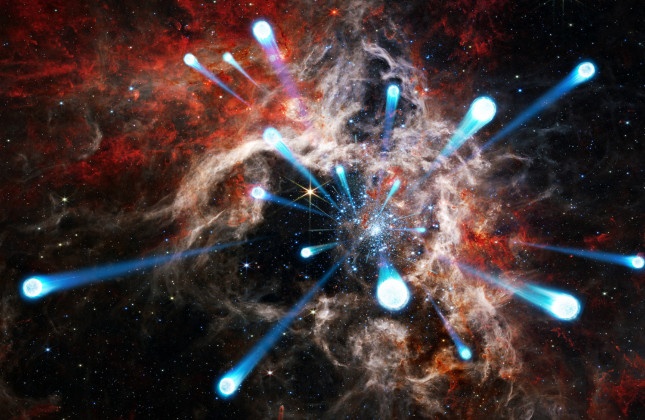
October 16, 2024 by Mark Thompson
Collected at: https://www.universetoday.com/168909/giant-cluster-is-spitting-out-massive-stars/
We live inside the Milky Way galaxy which is joined as it drifts through space by two satellite galaxies, the Magellanic Clouds. A star cluster in the Large Magellanic Cloud known as R136 has been the subject of a fascinating discovery. A team of astronomers have discovered 55 high-speed stars that have been ejected from the cluster. The discovery was made using the Gaia satellite and it seems up to a third of stars from the cluster have been ejected in the last century.
R136 is a massive star cluster in the Tarantula Nebula inside the Large Magellanic Cloud (LMC.) The LMC is a satellite galaxy of ours at a distance of around 160,000 light years. The cluster is among the most massive known and it contains some of the most massive stars ever observed. The stars are young at just a few million years old having formed out of the gas in the nebula.

When clusters form, the random movement of gas is transferred to the forming stars. With the movement of stars, crisscrossing the cluster it is not uncommon for stars to be ejected out. This was exactly what the team of astronomers observed using Gaia. The Gaia space observatory was launched back in 2013 by the European Space Agency and has been precisely mapping stellar positions since.

The team of astronomers led by University of Amsterdam PhD student Mitchel Stoop discovered the ejected stars travelling at speeds above 100,000 km/hr. You may have heard the saying ‘live fast, die young!’ Whether it’s true for humans is an interesting debate but it certainly seems true for stars. The most massive stars in the Universe fuse elements deep in their core at an alarming rate so will reach the end of their lives in just a few million years. Stars like those in R136 are a great example of this and, after being ejected to distances of around 1,000 light years, explode as supernova producing a neutron star or a black hole.
The measurements showed too that the stars have not been ejected over one particular period of the cluster’s history. The first event seems to have taken place 1.8 million years ago just when the cluster formed. Another event seems to have occurred around 200,000 years ago. Comparing the two events revealed an interesting difference. In the first event during the formation of the cluster, the stars shot off in almost random directions but in the second event, the stars moved in one general direction.
The co-author of the paper which was published in Nature, Alex de Koter said “We think that the second episode of shooting away stars was due to the interaction of R136 with another nearby cluster (that was only discovered in 2012). The second episode may foretell that the two clusters will mix and merge in the near future.”
The discovery that a third of the stars have been ejected from their point of origin shows that, through the ejection, they can influence other regions of the galaxy. It is even possible that ejected stars through the history of the evolution of the Universe could have contributed to the reionization of the universe by ultraviolet light. In this era, the universe transitioned from being filled with ionised gas to a more neutral era with electrons and protons combining to form neutral hydrogen atoms.
Source : Dozens of massive stars launched from young star cluster R136

Leave a Reply